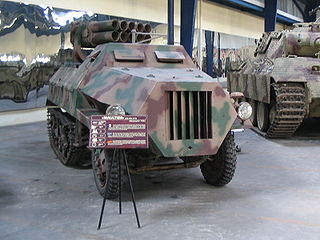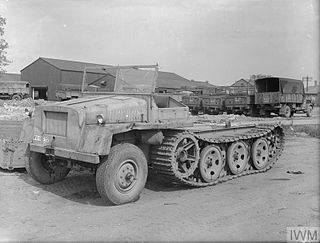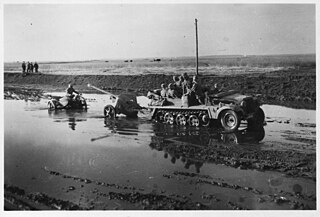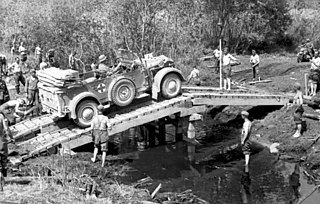Development
The Sd.Kfz. 4 was developed after the 1941 invasion of the USSR to deal with the ice and mud, which bogged down the wheels-only road-bound commercial vehicles that were used to supply German forces. It was a modified Standard Mercedes-Benz L4500S (4x2) with Horstmann suspension instead of a rear axle. Another manufacturer of 4.5-t truck, Büssing planned a similar conversion of its Büssing-NAG L4500S but did not proceed.
A total of 22,500 Maultier halftracks were produced by 1944, among which 1480 were 4.5-t. Sd.Kfz. 4, others 2-t. Sd.Kfz. 3. In 1943 Opel was directed to build armored vehicles outfitted with 15 cm Panzerwerfer 42 rocket launchers. [1] These vehicles were designated Sd.Kfz. 4/1, with around 300 produced. Given the extra weight of the Panzerwerfer, the top speed was only 24 mph (40 km/h). Another multiple rocket launching system, the 8 cm Raketen-Vielfachwerfer, was also fitted to the Sd.Kfz. 4 chassis.
The vast majority of Maultiers operated using British-pattern Carden-Loyd running gear, with the exception of the Type L4500R, which used PzKpfw. II running gear. The 6-cylinder engines were mated to a transmission with five forward gears plus reverse and could attain a maximum forward speed of 40 km/h. Each halftrack was equipped with the FuG Spr G f radio.
Aside from the Sd.Kfz. 4/1, the Sd.Kfz. 4 was armed only with a light 7.92 mm MG 34 or MG 42 machine gun with a traverse of 270° and elevation limits of -12° to +80°.

A multiple rocket launcher (MRL) or multiple launch rocket system (MLRS) is a type of rocket artillery system that contains multiple launchers which are fixed to a single platform, and shoots its rocket ordnance in a fashion similar to a volley gun. Rockets are self-propelled in flight and have different capabilities than conventional artillery shells, such as longer effective range, lower recoil, typically considerably higher payload than a similarly sized gun artillery platform, or even carrying multiple warheads.

A half-track is a civilian or military vehicle with regular wheels at the front for steering and continuous tracks at the back to propel the vehicle and carry most of the load. The purpose of this combination is to produce a vehicle with the cross-country capabilities of a tank and the handling of a wheeled vehicle.

The Sd.Kfz. 251 half-track was a World War II German armored personnel carrier designed by the Hanomag company, based on its earlier, unarmored Sd.Kfz. 11 vehicle. The Sd.Kfz. 251 was designed to transport the Panzergrenadier into battle. Sd.Kfz. 251s were the most widely produced German half-tracks of the war, with at least 15,252 vehicles and variants produced by seven manufacturers. The utility of this vehicle led the German Army to develop the similar looking but shorter and lighter Sd.Kfz. 250 as a supplement.

The Schwerer Panzerspähwagen, is a series of six- and eight-wheeled armoured cars that were used by Germany during the Second World War.

Maultier or Sd.Kfz. 3 is the name given to series of half-track trucks used by Nazi Germany during World War II. They were based on Opel, Mercedes-Benz, Alfa Romeo or Ford trucks.

The Sd.Kfz. 250 was a light armoured half-track, very similar in appearance to the larger Hanomag-designed Sd.Kfz. 251, and built by the DEMAG firm, for use by Nazi Germany in World War II. Most variants were open-topped and had a single access door in the rear.

The Sd.Kfz. 6 was a half-track military vehicle used by the German Wehrmacht during the Second World War. It was designed to be used as the main towing vehicle for the 10.5 cm leFH 18 howitzer.

Opel Blitz was the name given to various light and middleweight trucks built by the German Opel automobile manufacturer between 1930 and 1975. The original logo for this truck, two stripes arranged loosely like a lightning symbol in the form of a horizontally stretched letter "Z", still appears in the current Opel logo. The Blitz name was then applied to the British-made Bedford CF when it replaced the Blitz in certain markets.

The Wurfrahmen 40 was a German World War II multiple rocket launcher. It combined a vehicle such as the Sd.Kfz. 251 halftrack or captured French Renault UE Chenillette with rocket artillery to form a more mobile and protected artillery piece than the towed Nebelwerfer. It was nicknamed Stuka zu Fuss and Heulende Kuh.

The Sd.Kfz. 7 was a half-track military vehicle used by the German Army, Luftwaffe and Waffen-SS during the Second World War. Sd.Kfz. is an abbreviation of the German word Sonderkraftfahrzeug, "special purpose vehicle". A longer designation is mittlerer Zugkraftwagen 8t, Sd.Kfz. 7, "medium towing motor vehicle 8t".

The German Panzerwerfer refers to either of two different types of half-tracked multiple rocket launchers employed by Nazi Germany during the Second World War. The two self-propelled artillery vehicles are the 15 cm Panzerwerfer 42 auf Selbstfahrlafette Sd.Kfz.4/1 and 15 cm Panzerwerfer 42 auf Schwerer Wehrmachtsschlepper.

The Schwerer Wehrmachtschlepper was a German World War II half-track vehicle used in various roles between 1943 and 1945. The unarmored models were used as supply vehicles and as tractors to haul artillery. Armored versions mounted anti-aircraft guns or a 10 barrel rocket launcher (Nebelwerfer). Fewer than a thousand were built before the end of the war, but production continued after the war of an improved model in the Tatra plant in Czechoslovakia.

The Sd.Kfz. 10 was a German half-track that saw widespread use in World War II. Its main role was as a prime mover for small towed guns, such as the 2 cm Flak 30, the 7.5 cm leIG, or the 3.7 cm Pak 36 anti-tank gun. It could carry eight troops in addition to towing a gun or trailer.

The Sd.Kfz. 11 was a German half-track that saw widespread use in World War II. Its main role was as a prime mover for medium towed guns ranging from the 3.7 cm FlaK 43 anti-aircraft gun up to the 10.5 cm leFH 18 field howitzer. It could carry eight troops in addition to towing a gun or trailer.

The Krupp Protze was a six-wheeled 6x4 German truck and artillery tractor produced between 1934 and 1941 and heavily used in World War II. It was powered by a 4-cylinder, 55 hp or, from 1936, 60 hp Krupp M 304 petrol engine. Its main purpose was to tow artillery, especially the 3.7 cm Pak 36 anti-tank gun, and transport motorized infantry.

The Sd.Kfz. 234, was a family of armoured cars designed and built in Germany during World War II. The vehicles were lightly armoured, armed with a 20, 50 or 75 mm main gun, and powered by a Tatra V12 diesel engine. The Sd.Kfz. 234 broadly resembles the appearance of Sd.Kfz. 231 .

The Opelwerk Brandenburg was a truck vehicle assembly plant, located in Brandenburg an der Havel, Germany. Built within seven months, it was opened by Adam Opel AG in November 1935 on the re-armament initiative of the Nazi government in order to ensure supplies of Opel Blitz trucks for the Wehrmacht armed forces. By 1944 more than 130,000 medium-weight trucks had been produced at the Brandenburg plant. Devastated by an Allied air raid on 6 August 1944, the facilities were dismantled and shipped east as reparations to the Soviet Union after the war.

Einheits-Pkw der Wehrmacht – literally: "standard passenger motor-car of the Wehrmacht" – was the Nazi German plan for a new, multi-purpose fleet of all wheel drive off-road vehicles, based on just three uniform chassis, specifically designed and built for the Wehrmacht. The plan was formulated in 1934, and vehicles were built from 1936 to 1943.



















